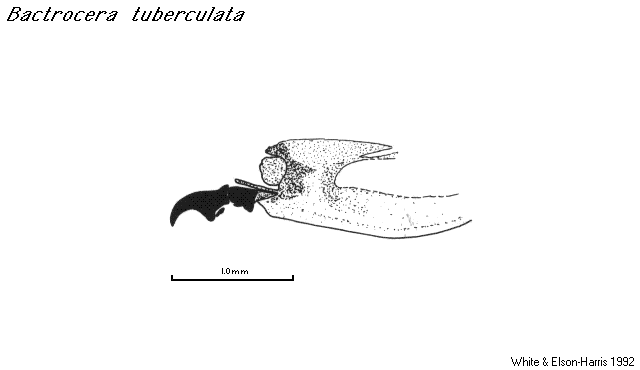Bactrocera tuberculata
Description
Typical of Bactrocera larvae with the following specific characteristics for the third instar:
Body. Body length 7.5–9mm.
Head. Stomal organ: number of peg sensilla three (long, tapered); peg sensilla unbranched; other peg-sensilla-like structures absent. Stomal region: secondary lobes short, leaf-like (4–5 preoral lobes); margins of secondary lobes all entire. Number of oral ridges 11–15; margins serrate, or scalloped (short, bluntly rounded teeth). Accessory plates small, shell-shaped; number of accessory plates 10; margins serrated. Median oral lobe absent or not protruding.
Spinules and creeping welts. Dorsal spinules on segments T1-T3.
Anterior spiracles. Anterior spiracular tubules 10–14.
Caudal segment (a8) and anal lobes. Anal lobes plainly visible, but not protuberant; simple.
Posterior spiracles. Slits 3x longer than wide (about). Dorsal spiracular processes with numerous trunks arising from an elongate base, or with numerous trunks arising from a short or semicircular base (long processes). Number of dorsal spiracular processes 11–14. Number of ventral spiracular processes 11–14. Number of lateral spiracular processes 8–12.
Host plants
| Family | Genus |
| Anacardiaceae | Mangifera |
| Rosaceae | Prunus |
Part of plant attacked: fruit.
Biogeographic region and distribution
OrientalChina (Yunnan), Burma.
Adult taxonomy
Bactrocera (Bactrocera) tuberculata (Bezzi)Chaetodacus tuberculatus Bezzi 1916: 106.—Burma. s. Shan: Taung-gyi, 4000 ft. or Myitkyima. HT ♂ BMNH.
References
Carroll, L. E., A. L. Norrbom, M. J. Dallwitz, and F. C. Thompson. 2004 onwards. Pest fruit flies of the world – larvae. Version: 8th December 2006. http://delta-intkey.com.
White, I. M., and M. M. Elson-Harris. 1992. Fruit flies of economic significance: their identification and bionomics. CAB International; Wallingford, UK. 601 p.



